Abstract
The shape of a bubble changes near an elastic boundary, and this alteration also influences the boundary itself. This study investigates bubble shape and boundary displacement near an elastic cylindrical boundary through an electric spark bubble experiment. Three parameters—dimensionless distance, elastic cylinder tension, and dimensionless size—are discussed and analyzed in relation to bubble shape. For studying elastic cylinder boundary displacement, a displacement formula is proposed by establishing a motion model, and impulse is used for verification. Furthermore, the elastic cylinder tension employed in this study has negligible impact on boundary displacement. Understanding how bubble shape changes near an elastic boundary, along with the corresponding boundary displacement, provides valuable insights into the stability and durability of materials and structures under similar conditions. The elasticity of the cylinder and its displacement response to external forces can help predict long-term behavior, contributing to the reliability assessment of engineering systems involving elastic boundaries and fluid dynamics.
1. Introduction
Bubbles near a horizontal rigid wall tend to generate high-speed jets directed toward the material during the rupture phase. In contrast, bubbles near a free interface will rupture along with the jet moving away from the interface. If the interface is neither “free” nor “rigid” (as is often the case in biomaterials), the resulting fluid dynamics can be complex. It is significant to know the direction of the jet, which can damage the tissue, or to predict it in advance to reduce the damage caused by the jet impact; this can have important implications for the support structures of offshore platforms [1]. Bubbles occur in many medical treatments, often as a result of high-intensity focused ultrasound, laser therapy, or shock wave lithotripsy. The physics of bubbles in the vicinity of elastic (soft) materials is even less well understood.
Current research on bubbles near elastic walls is shown in the schematic Figure 1. Similarly to the research near rigid planes, some scholars have studied the dynamic state of bubbles near fixed elastic boundaries, as shown in Figure 1a, where different materials are used as boundary conditions. These studies investigated bubble morphology and demonstrated bubbles’ influence on the boundaries of materials with different properties. Klaseboer et al. [2,3,4] considered the elasticity of a solid wall and studied the interaction between cavitation collapse and elastic structure. Using the finite element and boundary element method to solve the problem, it was found that cavitation may form a “mushroom-shaped” shape when the liquid medium is elastic. Siew wan fong [5] studied the growth and collapse shapes of bubbles near biomaterials; in some cases, the jet formed was directed away from the biomaterial, while in other cases, the jet was directed toward the biomaterial.
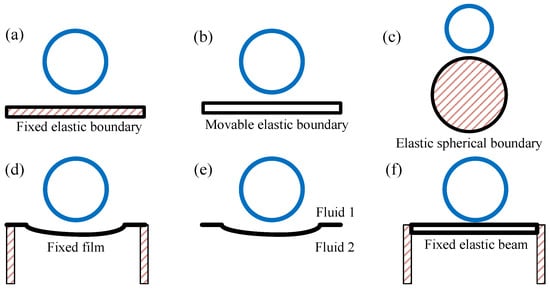
Figure 1.
Schematicof the study of bubbles near an elastic wall (the blue circle is the bubble). (a) Fixed boundary, (b) Movable boundary, (c) Sperical boundary, (d) Fixed film, (e) Fluid boundary, (f) Fixed beam.
In some cases, the bubble eventually splits into two parts, and regardless of whether opposite penetrating jets are formed, the jet’s high maximum velocities (700–900 m/s) away from or toward the biomaterial are observed. Zhang Aman and Yao Xiongliang et al. [6], based on potential flow theory, applied the boundary element method (BEM) to calculate the dynamics of underwater explosion bubbles near the boundary and combined it with the finite element method to calculate the interaction structure between bubbles and elastic plastics. Ohl S.W [7] used the BEM to solve some of the physics involved in these treatments to study the dynamics of bubbles near several biomaterials, whose behavior depends on the material properties of the biomaterials (Young’s modulus, Poisson’s ratio, and density). During the experiments, it was observed that the generated bubbles at certain moments formed jets in opposite directions. Qidong Yu [8] studied the acoustic pressure waves and transient flow structures emitted by a single bubble near an elastic boundary based on particle image velocimetry (PIV). The results showed that the bubbles near the elastic boundary present “mushroom-shaped” bubbles and “inverted cone-shaped” bubbles. Near the rigid and elastic boundaries, the bubbles have opposite migration directions; that is, they are repelled by the elastic boundary and attracted by the rigid boundary. Dular et al. [9] studied the damage caused by the collapse of a single cavitation bubble to aluminum foil and found that most of the damage was caused by the water hammer pressure during the microjet impact process. A single laser-induced cavitation bubble near agarose hydrogels with different degrees of elasticity was produced by A. B. Sieber [10]. The atomized part of a microjet can reach supersonic speeds up to 2000 m/s, while a fully developed liquid microjet travels at an average speed of up to 1000 m/s. In an experiment, Hendrik Reese [11] detected tangential stress on the elastic surface by measuring the displacement of the embedded particles and the deformation of the elastic structure. A corresponding numerical simulation was completed using the fluid–structure interaction volume solver in OpenFOAM-11. They found that deformation occurred not only when the bubble collapsed but also strongly during the initial expansion of the bubble. Brujan et al. [12,13] experimentally investigated the interaction of laser-induced cavitation bubbles with elastic boundaries, the elastic material consisted of polyacrylamide (PAA) gel, whose elastic properties could be controlled by varying the water content of the sample to simulate various biological tissues. For softer samples, the liquid jet was directed away from the boundary. If the bubble was generated near the boundary, the material was detached from the sample during bubble collapse. These processes play an important role in the efficiency and side effects of pulsed laser surgery in the human body. In Darja Horvat’s [14] experiments, the sample consisted of a piece of polymethyl methacrylate (PMMA) material and a thin polyethylene (PE) elastic membrane; this geometry is frequently encountered in ophthalmology. The evolution of the bubbles generated within the gap can be described as a characteristic combination of the rigid boundary and elastic membrane cases, depending on the relative sizes of the gap and the bubbles and their relative positions.
As shown in Figure 1b, Jin, Zeyu, and Yin [15] numerically studied the dynamics of underwater explosion bubbles interacting with a movable plate with the basic characteristics of a sandwich structure using the boundary element method. Three different states of bubble behavior were distinguished, and the sandwich plate can provide larger deformations and larger maximum deformation speeds, which is beneficial for changing the jet direction away from the plate. Han Lei et al. [11,16] studied the spatial evolution of a single bubble near the rigid and elastic boundaries. When the dimensionless parameter < 1.5, the jet effect dominated by high-speed jets and the mixed impact form can lead to asymmetric deformation and cause greater local damage to the elastic plate. Li Shuai [17] (the experimental structure is shown in Figure 1c) proposed that high-speed liquid jets are usually observed in the collapse stage of cavitation bubbles and proposed a surprising reflection flow (away from the boundary) that is formed in the early expansion stage of the bubble near the curved elastic boundary, which has not been reported before.
The elastic boundary is not only defined as an ordinary fixed boundary with a certain thickness, a film-like boundary composed of a film and two liquids of different densities, but also as a typical and common elastic boundary (as shown in Figure 1d,e). Turangan and Khoo et al. [18,19] used a low voltage of 55 V to generate spark bubbles and used numerical and experimental methods to explore the pulsation characteristics of bubbles near the elastic membrane. They found that the bubbles were coupled with the elastic membrane during movement, and disturbances occurred on the bubble surface, causing the bubbles to tear during collapse. They concluded that the distance between the bubbles and the elasticity of the membrane are two parameters that affect the movement of the bubbles. Ma et al. [20,21] also used a high-speed camera to study the interaction between bubbles and elastic membranes caused by electric sparks and found that bubbles showed a “mushroom-shaped” shape due to deformation during the contraction stage and rebound of the elastic boundary also occurred. U.Orthaber [22] generated cavitation bubbles by focusing a high-energy laser beam near an elastic membrane immersed in water, which corresponds to a situation often encountered in ophthalmology. Cavitation bubbles located in the center of the membrane produce less damage than bubbles slightly further away. In addition, Turangan [23,24] studied the transient oscillating bubble–elastic membrane interaction through experiments and numerical simulations. The coupling between bubble contraction and this disturbance intensifies the bubble’s collapse, leading to the formation of a “mushroom shape” of the bubble. At the end of the collapse, the inertia of the water around the bubble pulls the membrane upward, forming a relatively sharp conical protrusion. Ao Wang [25] experimentally studied the formation of two axial jets of bubbles caused by sparks near Ecoflex membranes of different thicknesses. The study found that the membrane deformation velocity caused by jet impact is an important factor in membrane puncture. Gong, SW [26] studied the physical behavior of the interaction between bubbles generated by sparks and a rubber beam (the experimental structure is shown in Figure 1f). The analysis shows that the ratio of the bubble beam distance to the maximum bubble radius affects the bubble evolution and beam deformation. The stiffness of the beam plays an important role in the response of the elastic beam to the expansion and collapse of the bubble. This may be applicable in biomedicine to deliver drugs to tissue (a soft material). It may also have applications in the marine industry [27], where ultrasonic bubbles are generated to descale the surfaces of ships coated with elastic materials.
Table 1 summarizes the materials used in some of the elastic boundaries above. The study of the proximity effect of elastic beams can be applied to many fields, such as medicine and ship engineering. The experimental structure and material properties used are worth learning from.

Table 1.
Elastic boundary material in the experiment.
It was found that boundary motion affects the dynamics of collapsing bubbles near elastic boundaries, resulting in changes in bubble shape, pressure wave fluctuations in the flow field, and the impact velocity of high-speed jets. These findings have implications for using cavitation in applications involving elastic boundaries, such as the microinjection of human muscle tissue and elastic shipbuilding. In bubble cleaning, when the rigidity of the object being cleaned is low, the jet near the wall does not necessarily point to the wall, and the bubble may tear or even jet away from the wall. It is precisely because the jet direction of the bubble near the elastic boundary is not completely directed to the wall that the destructive power of the jet on the structure is reduced. So, many scholars have proposed attaching a coating with specific properties to the surface of hydraulic machinery to slow down cavitation erosion. The effects of the bubble impact force and pressure wave on cylindrical structures have been evaluated, and then their fatigue life and reliability have been assessed [28]. There is also potential interest in underwater explosions near elastic structures.
In this study, Section 2 introduces the experimental setup and dimensionless parameters. Section 3 presents the bubble morphology and jet behavior under various parameter conditions. Additionally, it is observed that the displacement of the elastic cylinder caused by the bubble follows a specific pattern. The factors and models influencing this displacement are discussed, and a corresponding regularity formula is proposed. Section 4 provides a summary of the study and discusses the potential practical applications of the results.
2. Materials and Methods
2.1. Experimental Setup
The experimental setup is shown in Figure 2. The electric spark generates cavitation bubbles by short-circuiting an adjustable DC voltage carried by two thin wires with a diameter of 0.14 mm. The bubble size is controlled by the voltage, varying from 5.45 to 24.58 mm in diameter by voltages of 60–120 V [29]. The wires do not alter the bubble dynamics as they are thin enough. The wires and the elastic cylinder were placed in the middle of a tank filled with degassed tap water. The tank is large enough to ensure that the bubble behavior was not affected by either the free surface or the wall. The dynamics of the cavitation bubbles were filmed with a high-speed camera (FASTCAM SA-Z or NOVA S20, Photron, Tokyo, Japan) at 30,000 frames per second. Variables (length scales) were measured directly with calibrated high-speed images, with an uncertainty of 1 pixel. In the experiment, elastic cylinders with different tensions and thicknesses were used as boundaries to study the movement of bubbles. The radius of the elastic cylinder was always smaller than the maximum radius of the bubble. As shown in Figure 2, in the water tank, one end of the elastic cylinder was fixed on the stand, and the other end was passed around the fixed pulley. The tail end was connected to a weight to adjust the tension. Bubbles were generated just above the center of the elastic cylinder. The high-speed camera was placed opposite the background light.
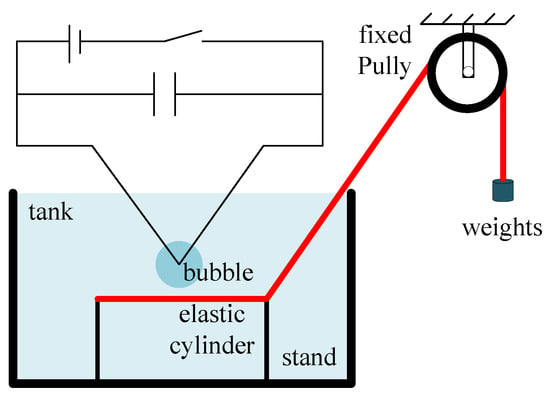
Figure 2.
Schematic of the study of a bubble near the elastic cylinder.
The material of the elastic cylinder was plastic elastic rope. The boundary conditions of the elastic cylinder were changed with the diameter and tension. Data regarding the working conditions for the elastic cylinder are shown in Table 2.

Table 2.
Elastic boundary conditions in the experiment.
2.2. Dimensionless Parameters
The overall experimental device was set up according to the schematic (Figure 2), and the figure below shows the images captured (Figure 3). The intersection of the two cross lines in Figure 3a is where the electric spark occurs; the distance from the initial position of the bubble to the center of the cylinder is d.
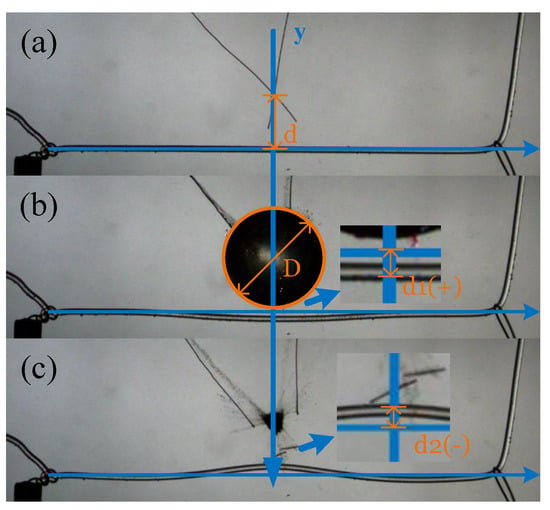
Figure 3.
Schematic of parameter measurement (a) d, (b) D and , (c) .
The maximum radius of the bubble was used to make the length dimensionless. In a free field, the bubble is basically spherical due to the absence of water structures and free liquid surfaces. If a structure is near the bubble, its boundary will make the bubble non-spherical, and when it expands to its maximum, it will have an irregular shape. If the boundary is elastic, then the bubble will push the boundary to move. At this time, the shape of the bubble is still generally approximately spherical. The maximum radius D of the bubble was measured when it expanded to its maximum, as shown in Figure 3b, . In addition, as shown in Figure 3b, when the bubble expands to the maximum, it will generate thrust on the elastic cylinder, causing the elastic cylinder to displace. The direction of the displacement is consistent with the direction of the y arrow in the figure, defined as positive displacement. The enlarged position on the right side of Figure 3b shows the measurement method of the positive displacement of the bubble and the elastic cylinder. The starting point is the initial position of the elastic cylinder, and the endpoint is the center position of the elastic cylinder when the bubble expands to the maximum. For displacement at the enlarged position in Figure 3c, since it is opposite to the y direction in the figure, it is defined as negative displacement. The measurement method considers the starting point the initial position of the cylinder, and the endpoint the center position of the elastic rope when the bubble completely collapses in the first cycle.
In the subsequent processes, this distance parameter will be dimensionless through the maximum bubble radius . The dimensionless parameters used are shown in Table 3, where is the radius of the elastic cylinder, is the density of the elastic cylinder, is the density of water, and d is the distance from the initial position of the bubble to the center of the cylinder.

Table 3.
Dimensionless parameters.
3. Results and Discussion
3.1. Bubble Motion
3.1.1. Bubble Motion near an Elastic Cylinder with Different Distances
This section will discuss the effect of the dimensionless distance parameter of the elastic cylinder boundary on the bubble morphology. Therefore, the parameters of the elastic cylinder remain unchanged, the tension of the elastic cylinder is taken as 0.49 N, and the dimensionless radius of the elastic cylinder is approximately . Figure 4a depicts the motion state of the bubble in two cycles under the condition of a dimensionless distance . The bubble expands to its maximum size at 0.92 ms and maintains a spherical shape during the expansion process, as shown at 0.39 ms and 0.60 ms. During the collapse process, the position where the elastic cylinder contacts the bubble will influence its shape. When the bubble collapses at 1.62 ms, the bottom contacts the surface of the elastic cylinder, and the bubble no longer maintains a completely spherical shape. At 1.72 ms, the bubble collapses, and the first cycle of the bubble ends. The bubble expands to the maximum in the second cycle at 1.97 ms. It can be observed that the bubble produces a jet away from the elastic cylinder in the first cycle, and the bubble with impurities and expansion in the second cycle produces displacement away from the wall. The situation where the bubble is slightly far from the elastic cylinder is shown in Figure 4b, and the dimensionless distance is . Under this condition, the bubble basically maintains a spherical shape before reaching the maximum volume. At this time, the elastic wall has little effect on the bubble morphology. The bubble expands to its maximum volume at t = 0.94 ms. At t = 1.70 ms, due to the collapse of the bubble and the existence of the elastic cylinder, the bubble is no longer spherical, and a sharp shape appears near the elastic wall. This is caused by the wall being attracted to the bubble. After the 1.99 ms bubble has completely collapsed, it can be observed that when the second cycle of the 2.31 ms bubble expands to the maximum, the centroid of the bubble moves toward the elastic wall. The jet points to the elastic boundary. During the secondary expansion of the bubble, affected by the wall and with its residual velocity before the jet, the bubble moves along the jet direction and eventually collapses near the wall. The situation where the bubble is far away from the elastic cylinder is shown in Figure 4c; the dimensionless distance is . Due to the long distance, the elastic wall has basically no effect on the shape of the bubble. The expansion and collapse of the bubble are basically spherical. There is no obvious difference between the bubble shape and the movement of the bubble in the free field. However, when the second cycle expands to the maximum moment (t = 2.61 ms), the displacement direction of the bubble’s centroid is toward the elastic cylinder.
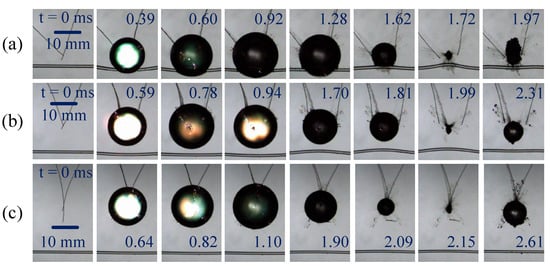
Figure 4.
Bubble morphology under the conditions of , , (a) , (b) , and (c) .
From the above analysis, it is evident that the shape of the bubble is related to the dimensionless distance, . Figure 4 presents interaction images of two-period bubbles and elastic walls in three typical cases. When the dimensionless distance is large (as shown in Figure 4c), the bubble retains a spherical shape, and the elastic boundary has no significant effect on the bubble’s movement. When the dimensionless distance is reduced (as shown in Figure 4b), the bubble no longer collapses spherically at the bottom during its collapse. When the dimensionless distance is small (as shown in Figure 4a), the bubble contacts the elastic boundary during the expansion process. In the early stage of collapse, it does not form a complete sphere but rather appears as two parts of a sphere with different radii, separated by the elastic boundary. In the middle stage of collapse, a mushroom-shaped bubble can be observed. In the late stage, the bubble significantly pulls the elastic cylinder.
3.1.2. Bubble Motion near an Elastic Cylinder with Different Tension Values
A change in tension is achieved by adjusting the weight at the other end of the elastic cylinder. The weights used were 50 g, 100 g, 150 g, 200 g, 300 g, and 400 g. This section presents the bubble morphology images of different dimensionless distances under the conditions of 0.49 N, 1.96 N, and 3.92 N tension of the elastic cylinder. Figure 5 shows the bubble morphology at several typical dimensionless distances when the tension is 0.49 N and the dimensionless cylinder radius . For , the bubble morphology is shown in Figure 5a. It is basically spherical during the expansion process. After it contacts the boundary at 0.48 ms, because the bubble wraps the elastic cylinder, the spherical radius of the bubble below is smaller than that of the normally growing bubble above. At 0.73 ms, after the bubble expands to its maximum size, it will wrap around the elastic cylinder and collapse, pulling the elastic cylinder to move in the direction of the collapse. The collapse speed of the bubble is greater than the movement speed of the elastic cylinder. In the late stage of bubble collapse, the bubble will separate from the elastic boundary. The bottom of the bubble will adhere to the elastic boundary, resulting in the bubble no longer being a regular sphere in the late stage of bubble collapse but a mushroom shape with different stem lengths, where the stem length is related to the dimensionless distance.
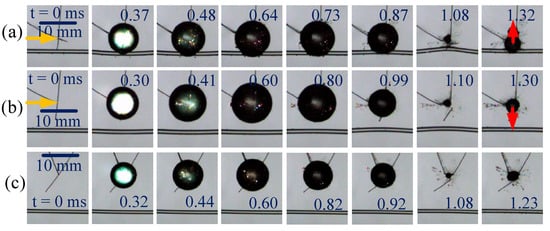
Figure 5.
Bubble morphology, where (a) , , and N; (b) , , and N; and (c) , , and N. (The red arrow is the direction of the jets).
Figure 5b shows the shape of the bubble when the distance is slightly long (). Since the boundary is elastic, during the expansion of the bubble, the bubble will push the elastic boundary to displace, so the bubble is basically spherical, with a slightly sharp shape at the bottom. During the collapse process, the boundary has attraction toward the bubble, and the bubble will produce a speed and acceleration opposite to that during expansion when it collapses, pulling the elastic boundary to displace. The side of the bubble far from the boundary remains spherical during the collapse process, while the side close to the boundary becomes sharp due to complex interactions, as shown in Figure 5b at 0.99 ms. Figure 5c shows the shape of the bubble at a slightly longer distance (). The bubble’s expansion and collapse are both spherical, which is consistent with its movement in the free field. It can be seen that at this dimensionless distance, the elastic boundary has no effect on the shape of the bubble.
Figure 6 and Figure 7 show that under the same dimensionless cylinder radius experimental conditions, the tension of the elastic cylinder is changed. The maximum tension used was 3.92 N, and no elastic cylinder experiment with a larger tension was conducted. This is because the elastic cylinder will deform under a larger tension. This elongation will cause the thickness of the elastic cylinder, that is, the radius, to change. This invisibly increases the number of variables, making the experiment more complicated. The processing of the experimental data is also inaccurate.
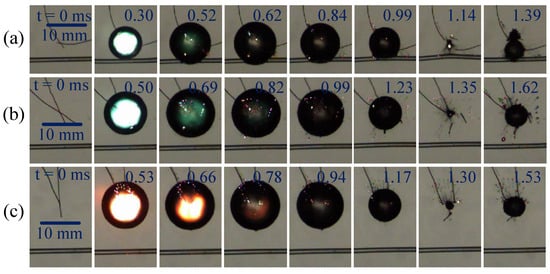
Figure 6.
Bubble morphology: (a) , , N; (b) , , N; (c) , , N.
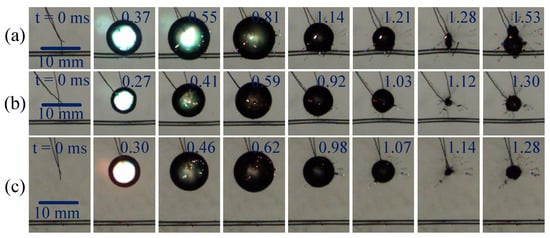
Figure 7.
Bubble morphology: (a) , , N; (b) , , N; (c) = 1.32, = 0.11, N.
In comparing Figure 5, Figure 6 and Figure 7, it can be found that under the tension conditions used in this study, the morphological changes in the bubbles are basically similar at typical dimensionless distances. When the bubble is close to the boundary, it make contact with the elastic cylinder. In the late expansion stage, the bubble no longer expands in a spherical shape and produces different collapse speeds during the collapse period, causing the jet phenomenon and the displacement of the elastic cylinder. When it is farther away, the spherical shape is maintained in the expansion stage; during the collapse, the elastic cylinder is attracted by the bubble and displaced in the direction of the collapse. When the dimensionless distance between the bubble and the elastic boundary is far, the bubble is consistent with the state in the free field.
3.1.3. Bubble Motion near an Elastic Cylinder with Different Rod Sizes
First, the size of the elastic boundary is dimensionless, , where is the actual size of elastic cylinder, and is the bubble radius when the bubble expands to the maximum. This section discusses the interaction between the bubble and elastic cylinder under four different dimensionless radius conditions, where 0.02, 0.04, 0.064, and 0.10.
Figure 8 shows bubble morphology images when with typical dimensionless distances. In Figure 8a, the elastic cylinder is much smaller the bubble ( 0.02), and the initial position of the bubble is close to the elastic cylinder. At 0.44 ms, it can be observed that the bubble pushes the elastic cylinder to move in the direction of bubble expansion, and the bubble wraps part of the elastic cylinder. At t = 0.76 ms, the elastic cylinder wrapped inside the bubble is no longer affected by the force and continues to displace. This state continues until the bubble expands to its maximum radius. In the collapse stage, the reduction in the bubble radius and the reverse acceleration during collapse will cause the displacement of the elastic cylinder to change, but the elastic cylinder of this size does not change the bubble shape much, and it still basically maintains a spherical shape.
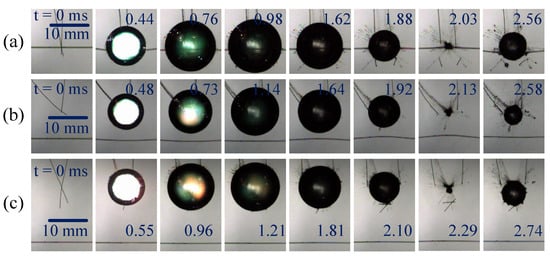
Figure 8.
Bubble morphology: (a) , , N; (b) , , N; (c) , , N.
In Figure 8b, the initial position of the bubble is slightly far from the elastic cylinder (), and the bubble basically remains spherical during expansion. During the collapse stage, due to the interaction between the elastic cylinder and the bubble, the bubble remains spherical on the side away from the elastic cylinder and becomes teardrop-shaped on the side close to the elastic boundary. It can be clearly observed that at this dimensionless distance, the displacement caused by the bubble collapse is larger than the expansion, which is related to the collapse velocity acceleration. As shown in Figure 8c, the initial position of the bubble is far away from the elastic cylinder (), and the shape of the bubble is no longer affected by the existence of the elastic boundary.
Figure 9 shows the bubble morphology at several typical dimensionless distances when . Figure 9a shows that the initial position of the bubble is close to the elastic boundary, and the bubble will contact the elastic boundary during expansion (). The bubble will push the elastic cylinder during expansion, causing it to remain spherical until the bubble contacts the boundary ( 1.01 ms). When the bubble collapses, it interacts with the elastic cylinder. At 1.81 ms, the bubble no longer maintains a spherical shape but is similar to a mushroom or light bulb shape. For a rigid cylinder, a mushroom-shaped bubble is likely to cause a jet away from the wall. At 1.53 ms, the image of the bubble expanding to the maximum radius in the second cycle shows that there is a jet away from the elastic wall.
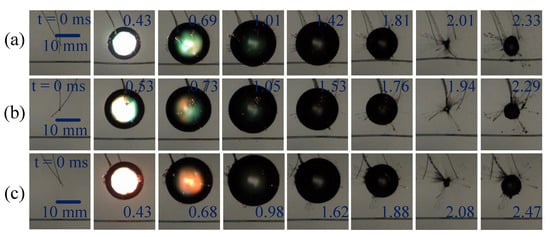
Figure 9.
Bubble morphology: (a) , , N; (b) , , N; (c) , , N.
Figure 4 shows bubble morphology images at several typical dimensionless distances when . The process of changing bubble morphology is similar to that of .
Figure 10 shows bubble morphology images at several typical dimensionless distances when . This elastic cylindrical boundary was the largest in the experiment, and it is similar to and different from the previous sizes. Figure 10a shows that the initial position of the bubble is close to the elastic boundary (); the bubble contacts the elastic cylinder during expansion. The side away from the elastic boundary still basically maintains a spherical shape, and the side close to the boundary will produce a reduction in radius and no longer maintain a consistent spherical shape. This is similar to the situation shown previously in Figure 4a. At a relatively long dimensionless distance, it is easier to produce a mushroom-shaped shrinking bubble ( 2.15 ms) during collapse. After the bubble is completely collapsed, it will cause the displacement of the local boundary. Figure 10b,c are the cases where the dimensionless distance is larger. For Figure 10b, it is worth noting that the area of contact between the bubble and the elastic boundary after expansion is smaller, and the deformation of the spherical bubble during expansion is smaller. On the contrary, in the collapse stage, as shown in 2.01 ms, the bubble is close to the elastic cylindrical boundary. Due to the interaction, the bubble is deformed and its shape is more like a bulb, or a mushroom with a longer stem. The deformation here is related to the dimensionless distance and the dimensionless radius of the elastic cylinder. In Figure 10c, the expansion and collapse of the bubble are still basically spherical, indicating that the influence of the dimensionless distance on the bubble deformation is greater. However, at 1.90 ms, it can be observed that the elastic cylinder still has a small displacement due to the collapse of the bubble. At this dimensionless distance, although it has basically no effect on the deformation of the bubble, it still affects the deformation of the elastic boundary.
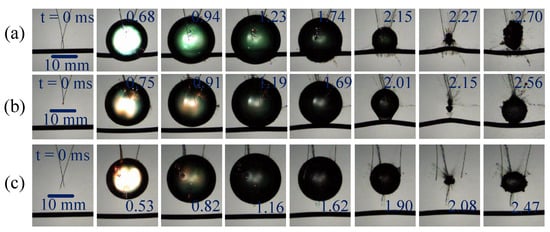
Figure 10.
Bubble morphology: (a) , , N; (b) , , N; (c) , , N.
The size of the dimensionless elastic cylinder will affect the bubble’s shape. The analysis here assumes that the dimensionless distance is close or slightly close because when it is large, the shape of the bubble is not affected by the dimensionless radius of the elastic cylinder. In other words, the dimensionless distance has a greater impact on the bubble shape. When is small, the bubble basically maintains a spherical shape during expansion and collapse, even if it touches or wraps the elastic cylindrical boundary, it will not affect the bubble’s spherical shape. When is slightly larger, during the bubble expansion process, when there is no contact, the bubble still basically maintains a completely spherical shape due to the elasticity of the boundary. When it collapses, the side away from the elastic cylindrical boundary remains spherical, but the side close to the elastic boundary will be more drop-shaped. When the bubble contacts or even wraps around the elastic cylinder, a slight deformation will occur during the expansion process. Both parts are basically spherical, but the radius of the end passing through the elastic boundary is smaller than the end away from it. This state continues until the bubble expands to its maximum or even in the early stage of collapse. In the late stage of collapse, the interaction between the bubble and the elastic boundary causes the bubble to have similar adhesion on the side close to the elastic boundary, and the collapse speed is significantly slower than that on the side away from it. At this stage, the bubble will appear in the shape of a bulb or mushroom.
3.2. Effect of Jet Direction
Elastic walls are different from rigid walls. In the initial stage of bubble expansion, even if is small, the shape of the bubble will basically not change. The direction of the jet cannot be determined by the bubble shape in the simple collapse stage. This shows that the influence of the elastic cylinder boundary on the bubble jet is more complicated than that of the rigid wall. The yellow arrow in Figure 5 indicates the initial position of the electric spark bubble, and the red arrow indicates the direction of the jet. The direction is determined by comparing the centroid of the bubble at the moment when it expands to its maximum in the second cycle with the initial position. Since there are too many factors to consider, such as the combined effects of the tension of the elastic cylinder boundary and the dimensionless radius, this study divided the jet directions into three categories: jets toward the elastic cylinder, jets away from the elastic cylinder, and no jets. No jet means that the bubble’s shape is always spherical during its movement, and the center of mass of the bubble after collapse is consistent with the location where the initial bubble occurs. The condition for division is the direction of the bubble cloud after the first cycle of bubble motion ends. By analogy, for the elastic cylindrical wall, the dimensionless distance and the properties of the elastic cylinder itself, such as the tension and the dimensionless radius, are also closely related.
3.2.1. Effect of Elastic Cylinder Tension on Jet Direction
Figures were plotted according to the classification of the jet direction to study the relationship between the elastic cylinder’s tension and the bubble jet’s direction. Figure 11 shows the functional relationship of , where the horizontal axis is the elastic cylinder tension in N, and the vertical axis is the dimensionless distance between the initial position of the bubble and the elastic cylinder boundary. The black asterisk represents the state without jets, the blue inverted triangle represents the direction of the jet pointing to the elastic cylinder wall, and the pink equilateral triangle represents the jet away from the elastic cylinder wall. The figure can be divided into three parts: region I, region II, and region III.
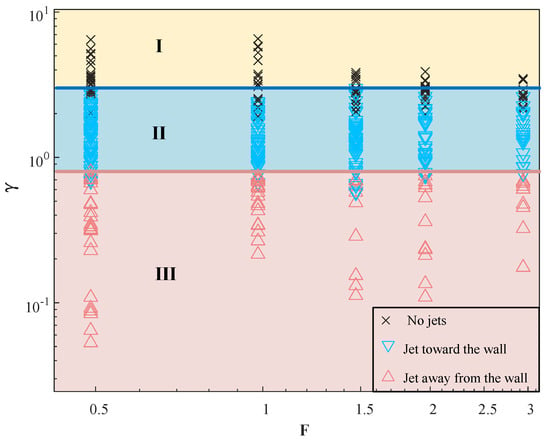
Figure 11.
Effect of elastic cylinder tension on bubble jet direction.
The black asterisks basically exist in region I (yellow shading). When the vertical coordinate value is greater than the blue boundary line, the bubbles appear to have no jets; that is, the dimensionless distance can be regarded as infinite. This dimensionless distance is shorter than the dimensionless distance without jets near the rigid cylinder, which is related to the size of the elastic cylinder and the properties of the material. From the horizontal direction, the no jet situation in region I has little to do with the tension of the elastic cylinder. Even if the tension is increased, the size of the dimensionless distance is still the key factor in determining whether a jet is generated. Almost all pink equilateral triangles are contained in region III (pink shading). After the bubble collapses in this region, the bubble cloud moves away from the elastic cylinder, which is defined in this paper as the jet moving away from the elastic cylinder wall. It can be observed that this is similar to a jet near a rigid wall. That is, when the dimensionless distance is short, a jet moving away from the cylindrical wall is produced. For the elastic cylindrical boundary, the position of the boundary is not fixed but displaced as the bubble expands. Due to different tensions, at the same dimensionless distance, the displacement caused by the bubble pushing the elastic cylindrical boundary will be different, and the interaction between the bubble and the elastic cylindrical boundary will also be different. In region II (blue shading), almost all blue inverted triangle symbols exist. The jet pointing to the cylinder wall is represented by a blue inverted triangle, which includes bubbles with jets pointing only to the wall and bubbles with jets pointing in both directions, but the jets pointing to the wall are dominant. In summary, after the bubble cycle ends, the bubble cloud’s direction is toward the cylindrical wall. This section defines it as a jet directed toward the elastic cylindrical wall. In the vertical direction, region II sandwiched between the blue boundary line and the pink boundary line in Figure 11 is the jet generated by the bubble, and the direction of the jet is the jet directed toward the elastic cylindrical wall.
To summarize the jet direction in the figure, the relationship between the jet direction and the dimensionless distance is as follows:
The above discussion discusses the influence of elastic cylinder tension on the direction of the bubble jet and gives the corresponding division of two boundaries and three regions. In the process of studying bubble morphology, it was found that the relative radius of the elastic cylinder also affects the bubble jet. Then, the following will discuss how the dimensionless radius of the elastic cylinder affects the jet direction near the boundary of the elastic cylinder.
3.2.2. Effect of Elastic Cylinder Size on Bubble Jet Direction
Figure 12 shows the effect of the dimensionless size of the elastic cylinder on the direction of the bubble jet. The figure shows the functional relationship of , where the horizontal axis is the dimensionless radius of the elastic cylinder, and the vertical axis is the dimensionless distance between the initial position of the bubble and the boundary of the elastic cylinder. The asterisk indicates no jet, the inverted triangle indicates the jet pointing to the wall of the elastic cylinder, and the equilateral triangle indicates the jet away from the wall of the elastic cylinder. The blue, pink, orange, and black colors are elastic cylinders with actual diameters of 0.4 mm, 0.8 mm, 1.2 mm, and 2.0 mm.
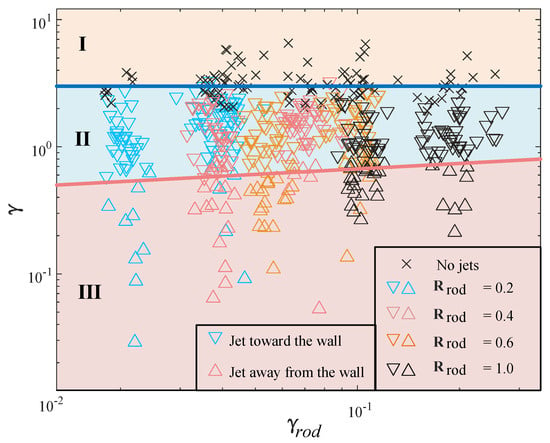
Figure 12.
Effect of elastic cylinder size on bubble jet direction.
Similarly to the effect of elastic cylinder tension on the jet direction, Figure 12 can also be divided into three regions: region I, region II and region III. The classification of the jet direction remains consistent in this paper. Region I is a bubble without a jet, region II is a bubble with a jet, where the jet direction points to the elastic cylinder wall, and the working condition in region III is that the jet is away from the elastic cylinder. Regarding the downward vertical direction of Figure 12, the asterisks basically exist in region I (yellow shading). The dimensionless distance can be regarded as the movement of the bubble on the free surface. The dimensionless distance of the elastic cylinder boundary is equivalent to the influence at infinity, which is consistent with the previous discussion in this section. From the horizontal direction, although the dimensionless size of the elastic cylinder changes, the dimensionless distance of the jet is not affected by its size.
In region III (pink shading), all the equilateral triangles are distributed in this area, which is divided by another boundary, below, which indicates the jets away from the elastic cylinder wall. This is similar to the inference of jets near the rigid cylindrical wall and the elastic cylindrical boundary. The direction of the jet is related to the dimensionless distance. When the dimensionless distance between the bubble and the wall is small, a jet away from the cylindrical wall will appear. After fitting, the boundary satisfies the following formula:
For region III, from the horizontal direction, as the dimensionless size of the elastic cylinder increases, the dimensionless distance required to produce a jet far away from the cylinder boundary becomes larger; that is, when the size of the elastic cylinder is large, a jet far away from the boundary can be produced under a slightly smaller dimensionless distance condition. This situation can be explained by the following analysis.
Figure 13 is a schematic of bubbles surrounding the elastic cylinder boundary. The two bubbles in the figure are the same size, and Figure 13a shows the situation when the elastic cylinder is smaller. For the assumptions made in the pink boundary, the larger the elastic cylinder boundary size, the smaller the dimensionless distance required to generate a jet away from the elastic cylinder wall. Based on this schematic, this paper discusses some of the assumptions. Figure 13a,b are compare, where the bubble size and dimensionless distance are the same, and the only different parameter in these two cases is the size of the elastic cylinder.
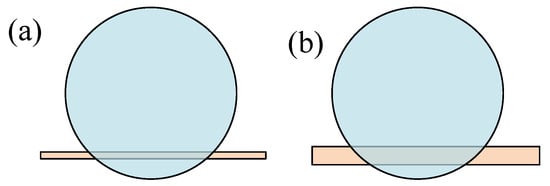
Figure 13.
Schematic of bubbles surrounding the elastic cylinder. (a) bubble around thin cylinder; (b) bubble around wide cylinder.
Due to the difference in size, first of all, it was proposed in the previous analysis of bubble morphology that after the elastic cylindrical boundary is wrapped, the bubble will deform and be divided into two spheres along the elastic boundary. The size of the bubble on the side close to the cylindrical boundary is smaller than that on the side far away. Under the same dimensionless distance, the larger the dimensionless radius of the cylinder, the more obvious the difference in size between the two parts of the bubble; that is, the more obvious the deformation of the bubble after expansion. Secondly, the larger dimensionless size also means that the contact area between the bubble and the cylindrical boundary is larger, so during the bubble collapse process, the area of interaction between the elastic cylindrical boundary and the bubble is larger. The bubble attached to the boundary of the elastic cylinder will produce a larger curvature than that away from the boundary. During the collapse process, a composite velocity away from the elastic cylinder will be generated. When the velocity away from the elastic cylinder is greater than the velocity toward the wall, the bubble cloud will be carried away from the wall of the elastic cylinder, thus generating the jet away from the wall of the elastic cylinder defined in this section. In region II (blue shading), the inverted triangle symbols are almost all distributed in this region. When the conditions in this region are met, the bubble will generate a jet, and the direction of the jet is toward the boundary of the elastic cylinder.
To summarize the jet direction in Figure 12, the relationship between the jet direction and and is as follows:
3.3. Effect of Bubbles on Displacement of Elastic Cylinder
As discussed in the previous section on bubble morphology and elastic cylinder displacement, there exists a complex relationship between bubble shape and the displacement of the elastic cylinder, which extends beyond the influence of the dimensionless distance. It is not necessarily the case that the closer or farther the primary bubble is to the elastic cylinder boundary, the larger the displacement at the lowest or highest point of the elastic cylinder boundary. Moreover, under the same conditions, it does not imply that both the highest and lowest point displacements occur simultaneously. This is an important point to note.
In this section, the maximum displacement of the elastic cylinder is non- dimensionalized as , where . Figure 14 illustrates the relationship between the maximum displacement and dimensionless distance during the expansion and collapse of the bubble in several experiments. It can be observed that, on the graph, the maximum value of the maximum displacement differs between the collapse and expansion processes as the dimensionless distance changes, with the collapse process requiring a larger dimensionless distance. This section will specifically examine whether there are conditions for the maximum displacement and summarize the pattern of elastic boundary displacement, which will have positive implications for both the maritime and medical fields.

Figure 14.
Trends in dimensionless maximum displacement and dimensionless distance during expansion and collapse for some experiments.
3.3.1. Model of Elastic Cylinder Displacement
The influence of bubbles on the elastic rope can be divided into several stages. In the first period, when the bubbles are active, the bubbles will push the elastic cylinder to move, and the elastic cylinder will produce the maximum displacement along the expansion direction. Since the two ends are fixed, the elastic cylinder is arc-shaped as a whole. This state continues until the bubble expands to the maximum radius. The bubble undergoes the first cycle of collapse motion. When the elastic cylinder is not wrapped, the bubble is clearly pulling it to move in the collapse direction. When the elastic cylinder is in contact with or wrapped by the bubble, the boundary is not pulled to displace until the bubble is about to break away from the boundary of the elastic cylinder in the late stage of collapse. After this period of movement, the elastic cylinder will make periodic fluctuations. Due to the complexity of its movement and the importance of the maximum displacement, this paper only focuses on the study of the maximum displacement of the bubble’s expansion and collapse in the first movement cycle. In order to study the displacement of the elastic cylinder, a bubble motion model and an elastic cylinder force model are proposed, and then the maximum displacement is derived and verified.
Assume that the bubble radius moves in a spherical motion in the form of , and set the cylinder velocity surface to a sphere with a radius of r and the same center as the bubble, with a velocity of . According to mass conservation in the incompressible flow field,
The velocity on the concentric sphere of the bubble is obtained as follows:
The velocity in the y direction is decomposed at the position where the concentric sphere contacts the boundary of the elastic cylinder, and the velocity in the y direction at the position where the concentric sphere contacts the elastic cylinder is obtained:
When , the asymptotic growth rate of the cavitation bubble is
The MRG algorithm yields . The acceleration at the initial stage of cavitation growth is
The initial growth time of the bubble can be calculated as
This paper proposes the existence of a distance reference value , where is the limit distance at which the elastic cylinder boundary can produce deformation. When , that is, , the elastic cylinder boundary will not be displaced because the distance is long enough. When , that is, , at this distance, according to the discussion in the previous section, since the size of the elastic cylinder is not large enough, and the two ends of the boundary are fixed but elastic, the expansion movement of the bubble can push the elastic cylinder to displace. The bubble can continue to maintain a spherical shape during the expansion process, and this state conforms to the Rayleigh–Plesset equation. At this time, it can be concluded that the time for the bubble to move to the maximum radius is
When , that is, , the bubble in the expansion process will make contact with the elastic cylindrical boundary. Since the elastic cylindrical boundary size used in this article is much smaller than the maximum radius of the bubble, when the dimensionless distance is closer, the bubble will wrap the elastic cylinder, and the first wrapped position is the tangent, that is, the intersection of the bubble’s vertical direction and the elastic cylindrical boundary. Here, this paper assumes that for the bubble in the expansion period, at the moment when the bubble contacts the elastic cylinder boundary, the intersection position of the vertical line through the bubble generation point and the elastic cylinder boundary already exists inside the bubble and is no longer subject to the thrust of the bubble. Under this condition, it is considered that the time history of the elastic cylinder being subject to the thrust of the bubble is the moment when the bubble expands to a radius of , and there is a gradual movement speed during the expansion process. Based on this, the time when the bubble contacts the elastic cylinder boundary can be obtained as
where is the bubble velocity when . In addition, the bubble expands fastest at the initial stage, and the bubble radius growth curve tends to be flat as the radius increases. At the moment of contact with the elastic cylinder boundary, the larger the bubble’s dimensionless distance, the smaller the bubble growth rate. This algorithm for calculating time for displacement and average velocity has certain problems. The closer the dimensionless distance, the shorter the time, and the farther the dimensionless distance, the longer the time history. Therefore, it is necessary to set the coefficient A to calculate the time according to the velocity at the moment of contact.
Based on the above discussion, the relationship between the dimensionless distance and the time of action of the thrust exerted by the bubble can be obtained as follows:
Constructing models for both the elastic cylinder and the bubble is essential for analyzing the forces acting on the elastic cylinder. During the bubble’s movement, the elastic cylinder will experience its own tension and forces. It is assumed that force is generated during the expansion of the bubble, causing the entire elastic cylinder to deform. The shape of the elastic cylinder is modeled as an arc of a circle. As shown in Figure 15, the dark red region represents the overall deformation of the elastic cylinder, which forms a segment of a circle with a radius of . The bold black line represents the initial position of the elastic cylinder. The total length of the elastic cylinder is L. According to the coordinate system shown in the figure, , where x is the position along the cylinder, R is the bubble radius, is the radius of the elastic cylinder, is the maximum bubble radius, and is the liquid density.
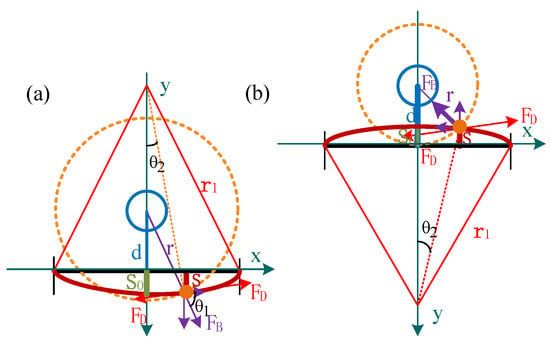
Figure 15.
Schematic of elastic cylinder under load. (a) The expansion process, (b) The collapse process.
Figure 15a is a schematic of the overall force of the elastic cylinder during the bubble expansion process, and Figure 15b is a schematic of the overall force of the elastic cylinder during the bubble expansion process.
To study the displacement of the elastic cylindrical boundary, the elastic boundary curve after being pushed by the bubble is assumed to be an arc, where the maximum displacement in the y direction of the arc is . Substituting the three known points , , and into the equation , we can obtain the circle formed by and L:
After obtaining the equation of the circle, we can find the coordinates of any point on the arc. When the horizontal coordinate is x, the displacement of the elastic cylinder in the y direction is S. In substituting the point into the circle equation, there are two solutions for S. Here, we take the positive value.
S is the displacement of the elastic cylinder at any position on the arc, and is the maximum displacement of the bubble elastic cylinder caused by the bubble movement when .
3.3.2. Force Analysis of Elastic Cylinder
The forces on the orange dots are shown in Figure 15. The displacement of the elastic cylinder boundary is mainly caused by the thrust or pull of the bubble and the pull on the elastic cylinder boundary itself. First, it is subjected to the internal pull , and the direction of the pull is tangent to this circle. The force caused by the bubble movement on the elastic cylinder is analyzed below. In this paper, the elastic cylinder is assumed to be subjected to the lift force given by the bubble in the y direction. The lift formula is . This formula is used to calculate the lift generated by a fluid on the surface of an object. In this formula, the lift coefficient is a very important parameter. It represents an object’s efficiency in generating lift, and its value depends on many factors, such as the shape of the object, the angle, the properties of the fluid, and the speed. V is the velocity of the fluid, usually the velocity of air, because in most aviation applications, the fluid is air. V in this paper is the velocity of the water flow. W represents the surface area of the object in the fluid, usually the area of the obstacle.
In this paper, the water velocity is , and the surface area is the area of the local elastic cylinder . Substitute it into the lift formula:
According to Formula (15), the length of the elastic cylinder is , and the force exerted by the bubble on this section of the elastic cylinder is
From the approximate circle of the elastic cylinder and , the component of the elastic cylinder’s velocity in the y direction can be obtained:
First, the displacement during the bubble expansion process is discussed. During this process, the elastic cylinder boundary is subjected to the thrust caused by the bubble expansion and the tension exerted on the elastic cylinder itself. At this time, the force exerted on the elastic cylinder boundary in the y direction at time t is
Regarding the force on the boundary of the elastic cylinder, we will continue to discuss its several classifications using the dimensionless distance proposed in the previous section. The main situations discussed are shown in Figure 16. Figure 16a shows the dimensionless , that is, where the bubble contacts or even wraps the elastic cylindrical boundary after expansion movement. Figure 16b shows . That is, the dimensionless distance is long, and the bubble will expand in a spherical state until the maximum radius.
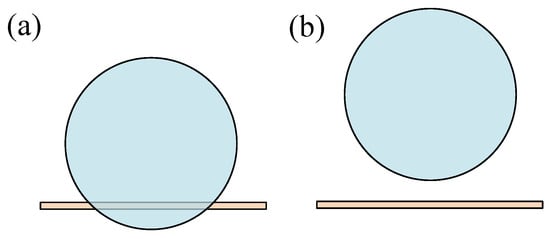
Figure 16.
Schematic of the effect of dimensionless distance on the elastic cylinder wrapped by the bubble. (a) small , (b) large .
When , the bubble will wrap around the elastic cylinder boundary during the expansion process. The radius of the bubble when wrapping around the elastic cylinder boundary is , which is the sum of the distance from the initial position of the bubble to the elastic cylinder and the displacement of the elastic cylinder boundary caused by the bubble expansion. In order to simplify the expression of the formula, the thrust coefficient applied by the bubble to the elastic cylinder is set to K, ; for a length of , the force on the elastic cylinder boundary at time t is
For the intersection of the elastic cylinder boundary perpendicular to the bubble (), the length is , the mass of this section of the elastic cylinder , and the tension . Under this condition, is the displacement of the elastic cylinder boundary from the initial moment of the bubble to the contact time t between the bubble and the elastic cylinder boundary. According to the previous assumption, no displacement will occur after the elastic cylinder is wrapped by the bubble. Therefore, is the displacement of the elastic cylinder under the state:
Substitute the asymptotic velocity and time t. At this time, t is taken as , and . At this time, we obtain a quadratic equation about . Solve this quadratic equation; the low-order infinitesimals about d within the square root are omitted, and the solution of is
The parameter used for the dimensionless length in this paper is the maximum radius of the bubble. The dimensionless elastic boundary displacement is
When , the distance from the initial position of the bubble to the boundary of the elastic cylinder is greater than the maximum radius of the bubble after expansion. Since the bubble generates thrust on the bubble during expansion, the bubble continues to maintain a spherical shape during expansion and does not contact the boundary of the elastic cylinder. At this time, . In addition, is in this case, and t is like in the expression when in Equation (12), and the displacement at this time is obtained as follows:
When , the dimensionless elastic boundary displacement is
The dimensionless elastic cylinder boundary displacement obtained after the above discussion on dimensionless distance is sorted out as follows:
3.3.3. Results on the Displacement of the Elastic Cylinder
In the previous section, we derived the relationship between the displacement of the elastic cylinder and the dimensionless distance when the value is different, where is used as the boundary; that is, whether the bubble and the elastic cylinder are in contact is used to distinguish between the two conditions. The following will show and analyze the effects of dimensionless distance and tension on the displacement of the elastic cylinder. Whether near a rigid wall or an elastic wall, dimensionless distance is an important factor affecting the bubble morphology and boundary state.
Figure 17 shows the relationship between dimensionless distance and the maximum displacement of elastic cylinders of different sizes. The blue circle in the figure is the maximum displacement of the elastic cylinder during bubble expansion. In this paper, the displacement direction of the elastic cylinder is defined as positive; the red circle is the maximum displacement of the elastic cylinder during bubble collapse. The maximum displacements of the expansion and collapse of elastic cylinders of the same size are plotted on the same figure.
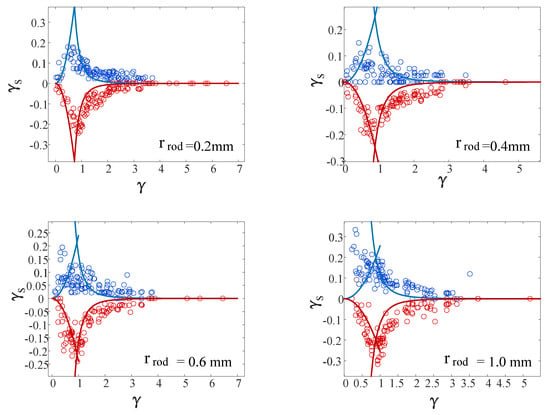
Figure 17.
Relationship between dimensionless distance and maximum displacement of elastic cylinders of different sizes. The red color is for the expansion process, the blue is for the collapse process.
The curve shown in Figure 17 is the result drawn according to Formula (25), where the values are and . It can be seen that the larger the , the better the maximum displacement during the expansion, which is consistent with the data points in the figure. When the dimensionless distance , the bubble basically has no effect on the displacement of the elastic cylinder, which also means that the elastic cylinder does not affect the morphology of the bubble as a boundary. In addition, the derivation of the maximum displacement of the elastic cylinder in the above text is correct, and it can describe the trend and size of the maximum displacement of the elastic cylinder. The dimensionless distance range of the elastic cylinder displacement is mainly , among which the maximum displacement occurs in the range of . The reason why the elastic cylinder produces the maximum displacement in this range is worthy of further study. The concept of impulse will be used for analysis and discussion below.
For the discussion in the previous section, there exists , which is shown as in Figure 17. When , the movement of the bubble will push or attract the elastic cylindrical boundary to produce displacement. Due to the difference in dimensionless distance, the time when the bubble contacts the elastic cylindrical boundary is also different. The premise of this study assumes that when the bubble contacts or wraps the elastic cylinder boundary, the elastic cylinder will no longer continue to displace. When the dimensionless distance is small, the bubble has a relatively large initial velocity at the beginning of its expansion but contacts the elastic cylinder quickly. The accumulation of movement time is small, so the elastic cylinder boundary will not produce a large displacement. When the dimensionless distance is large, the elastic cylinder receives a small thrust from the bubble at the position, and there is basically no speed transmission. Even if the time of the entire bubble expansion cycle is accumulating, it still will not produce a large displacement. However, when the dimensionless distance is appropriate, the bubble has both a higher velocity and a longer time to accumulate displacement, and the displacement of the elastic cylinder is large at this time. This setting can theoretically explain why the maximum value of the maximum displacement is in the interval . This involves the accumulation of force given to the elastic cylinder by the bubble, and the accumulation of force over time is also the definition of impulse. Therefore, the relationship between the displacement of the elastic cylinder can be proved by the impulse received by the elastic cylinder. That is, there is a dimensionless distance that makes the impulse have a maximum value, which is manifested as the maximum displacement of the elastic cylinder boundary having a maximum value.
In classical mechanics, the impulse of the resultant external force on an object is equal to the increment in its momentum (i.e., the final momentum minus the initial momentum), which is called the momentum theorem. Impulse is a process quantity that represents the cumulative effect of a force on an object over a period of time.
For the dimensionless conversion of impulse, impulse is equal to the increment in momentum; that is, the units of impulse and momentum are the same. In this paper, the momentum of bubble drainage is used to make the impulse of elastic cylinder dimensionless, where the momentum of bubble drainage is :
So, the dimensionless impulse of the elastic cylinder is
where .
For the case where the dimensionless distance is slightly larger (), by substituting the time and the force into the Equation (26), we obtain the following expression:
At this time, the impulse of the bubble is the product of the maximum volume of the bubble and the average velocity:
In this case, the dimensionless impulse is
To summarize, there are two types of dimensionless impulse:
Substitute and into formula (32) to plot the graph of the dimensionless distance and dimensionless impulse of the elastic cylinder, as shown in Figure 18.
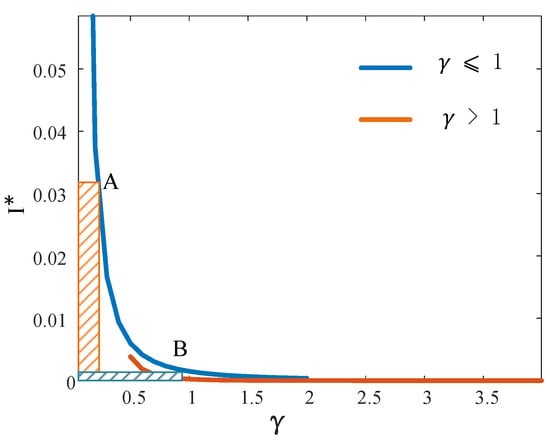
Figure 18.
Dimensionless distance and dimensionless impulse of the elastic cylinder.
The blue curve in the figure is , and the orange curve is . The trend in the image is consistent with the findings of this article. When the dimensionless distance is small, the elastic cylinder boundary is subjected to a large impulse, but because is small, the impulse accumulation time is short, as shown in point A in the figure; the elastic cylinder does not necessarily have the maximum value of the maximum displacement. When the dimensionless distance is large, as shown in point B in the figure, although the elastic cylinder has a long impulse accumulation time, the impulse has decayed, and the maximum displacement value will also be smaller than the maximum value. Therefore, there is a maximum value of in this interval, and the maximum value is related to the impulse size and the dimensionless distance. This is a complex process and is also closely related to the properties of the boundary conditions themselves. It is worth discussing in depth in future scientific research.
The main variables for the elastic cylinder in this paper are the dimensionless distance between the bubble and the elastic cylinder, and the variables of the elastic cylinder itself are the dimensionless size and the tension received. The dimensionless distance and dimensionless size were discussed in the previous discussion. The relationship between the tension and the maximum displacement of the elastic cylinder will be shown and discussed below.
Figure 19 shows the relationship between tension and the maximum displacement of the elastic cylinder and gives the maximum displacement of the expansion and collapse process of elastic cylinders of different sizes under different tensions. Different tensions have basically the same trend; that is, the value of the maximum displacement increases first and then decreases, and the maximum value of the maximum displacement is generated in the interval of , but it is difficult to observe the difference in displacement caused by tension with the same dimensionless size. The tension used in this study has no effect on the bubble morphology or the displacement of the elastic cylinder. This may be because the scale change in the tension in this article is not large enough to change the properties of the boundary itself or affect the morphology of the bubble, thereby affecting the thrust and a series of effects of the bubble on the elastic cylinder boundary. Increasing the range of tension, thereby affecting the interaction between the elastic boundary and the bubble, is also a complex issue worthy of in-depth study.
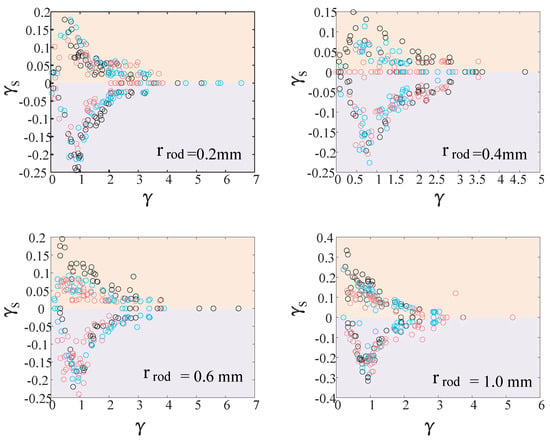
Figure 19.
Therelationship between the dimensionless maximum displacement and distance of the expansion and collapse of some experimental data.
4. Conclusions
In this study, the relationship between bubble morphology and elastic cylinder displacement was investigated through electric spark experiments. The focus was on examining the effects of dimensionless distance, tension, and cylinder size on bubble behavior and cylinder displacement. Additionally, the accuracy and practical applicability of the results were evaluated in conjunction with a reliability analysis.
First, the morphological changes in bubbles at different dimensionless distances were studied. At a larger dimensionless distance (), the bubble behaves in a free-field state, is almost unaffected by the elastic cylinder, and maintains a spherical shape. When becomes slightly smaller, the bubble may contact the cylinder but still maintains a spherical shape during expansion. This is closely related to the characteristics of the elastic boundary. In the contraction stage, the bubble morphology is significantly influenced by . When is small, the bubble will be divided into two hemispheres by the elastic cylinder after contacting it during expansion, and it will take on a mushroom shape during contraction. Tension has almost no effect on the bubble morphology. Regarding the effect of elastic cylinder size, when is small, the bubble mostly maintains a spherical shape during both expansion and contraction. As increases, the bubble remains spherical during expansion, but the side closest to the cylinder becomes drop-shaped during contraction, while the side away from the cylinder remains spherical. When the bubble contacts or wraps around the cylinder, slight deformation occurs during the expansion process. The interaction between the bubble and the cylinder during the contraction stage causes the side near the cylinder to collapse significantly slower, resulting in the bubble presenting a bulb or mushroom shape. In terms of elastic cylinder displacement, a cylinder force model is established in combination with the bubble motion model, and the displacement formula for the cylinder is calculated. The calculation results align well with the experimental data trend. An impact force experiment verified the displacement change and revealed the dimensionless distance at which the maximum displacement occurs based on the cumulative force action time. Additionally, tension has little effect on the displacement of the cylinder.
This study ensures the reliability of the results through repeated experiments and numerical simulations, confirming the consistency between experimental data and model calculations. The stability and accuracy of the conclusions were validated across variables such as dimensionless distance, tension, and cylinder size. The experimental and theoretical predictions of displacement and bubble morphology align closely, particularly in the design of elastic materials and the control of bubble dynamics. The findings contribute to a deeper understanding of bubble–elastic cylinder interactions, with wide applications in fluid mechanics, engineering design, and material reliability. This research also supports bubble control, the optimization of elastic structures, and reliability assessments in engineering practices.
Author Contributions
Conceptualization, Y.G. and D.S.; methodology, Y.G.; software, Y.G. and J.W.; validation, J.W.; formal analysis, Y.G. and D.S.; resources, Y.G.; writing—original draft preparation, Y.G.; writing—review and editing, D.S.; funding acquisition, D.S. All authors have read and agreed to the published version of the manuscript.
Funding
This research was funded by the National Natural Science Foundation of China (Grant No. 12172100).
Institutional Review Board Statement
Not applicable.
Informed Consent Statement
Not applicable.
Data Availability Statement
Data is contained within the article.
Conflicts of Interest
The authors declare no conflicts of interest.
References
- Meng, D.; Yang, S.; Yang, H.; De Jesus, A.M.; Correia, J.; Zhu, S.P. Intelligent-inspired framework for fatigue reliability evaluation of offshore wind turbine support structures under hybrid uncertainty. Ocean Eng. 2024, 307, 118213. [Google Scholar]
- Klaseboer, E.; Khoo, B.; Hung, K. Dynamics of an oscillating bubble near a floating structure. J. Fluids Struct. 2005, 21, 395–412. [Google Scholar] [CrossRef]
- Klaseboer, E.; Khoo, B.C. An oscillating bubble near an elastic material. J. Appl. Phys. 2004, 96, 5808–5818. [Google Scholar]
- Ong, G.P.; Khoo, B.C.; Turangan, C.; Klaseboer, E.; Fong, S.W. Behavior of Oscillating Bubbles Near Elastic Membranes: An Experimental and Numerical Study. Mod. Phys. Lett. B 2005, 19, 1579–1582. [Google Scholar] [CrossRef]
- Fong, S.W.; Klaseboer, E.; Turangan, C.K.; Khoo, B.C.; Hung, K.C. Numerical analysis of a gas bubble near bio-materials in an ultrasound field. Ultrasound Med. Biol. 2006, 32, 925–942. [Google Scholar] [PubMed]
- Zhang, A.; Yao, X.; Li, J. The interaction of an underwater explosion bubble and an elastic–plastic structure. Appl. Ocean. Res. 2008, 30, 159–171. [Google Scholar] [CrossRef]
- Ohl, S.W.; Klaseboer, E.; Khoo, B.C. The dynamics of a non-equilibrium bubble near bio-materials. Phys. Med. Biol. 2009, 54, 6313. [Google Scholar]
- Yu, Q.; Xu, Z.; Zhao, J.; Zhang, M.; Ma, X. PIV-based acoustic pressure measurements of a single bubble near the elastic boundary. Micromachines 2020, 11, 637. [Google Scholar] [CrossRef]
- Dular, M.; Poar, T.; Zevnik, J.; Petkovek, R. High speed observation of damage created by a collapse of a single cavitation bubble. Wear 2019, 418–419, 13–23. [Google Scholar] [CrossRef]
- Sieber, A.; Preso, D.; Farhat, M. Cavitation bubble dynamics and microjet atomization near tissue-mimicking materials. Phys. Fluids 2023, 35, 027101. [Google Scholar] [CrossRef]
- Han, L.; Hao, L.; Zhu, J.; Zhang, M.; Huang, B. Interaction of a single bubble and an elastic plate: Influence of the standoff distance. Phys. Fluids 2023, 35, 027107. [Google Scholar] [CrossRef]
- Brujan, E.A.; Nahen, K.; Schmidt, P.; Vogel, A. Dynamics of laser-induced cavitation bubbles near an elastic boundary. J. Fluid Mech. 2001, 433, 251–281. [Google Scholar] [CrossRef]
- Vogel, A.; Brujan, E.A.; Schmidt, P.; Nahen, K. Interaction of laser-produced cavitation bubbles with an elastic tissue model. In Proceedings of the Laser-Tissue Interaction XII: Photochemical, Photothermal, and Photomechanical, SPIE, San Jose, CA, USA, 21–24 January 2001; Volume 4257, pp. 167–177. [Google Scholar]
- Horvat, D.; Orthaber, U.; Schille, J.; Hartwig, L.; Löschner, U.; Vrečko, A.; Petkovšek, R. Laser-induced bubble dynamics inside and near a gap between a rigid boundary and an elastic membrane. Int. J. Multiph. Flow 2018, 100, 119–126. [Google Scholar] [CrossRef]
- Jin, Z.; Yin, C.; Chen, Y.; Hua, H. Numerical study on the interaction between underwater explosion bubble and a moveable plate with basic characteristics of a sandwich structure. Ocean Eng. 2018, 164, 508–520. [Google Scholar] [CrossRef]
- Lei, H.; Mindi, Z.; Zhenkun, T.; Guohao, H.; Biao, H. Investigation of the energy conversion process of a single bubble collapsing near different boundaries. Ocean. Eng. 2023, 277, 114063. [Google Scholar] [CrossRef]
- Li, S.; Zhang, A.M.; Han, R. Counter-jet formation of an expanding bubble near a curved elastic boundary. Phys. Fluids 2018, 30, 121703. [Google Scholar] [CrossRef]
- Klaseboer, E.; Turangan, C.K.; Khoo, B.C. Dynamic behaviour of a bubble near an elastic infinite interface. Int. J. Multiph. Flow 2006, 32, 1110–1122. [Google Scholar] [CrossRef]
- Turangan, C.K.; Ong, G.P.; Klaseboer, E.; Khoo, B.C. Experimental and numerical study of transient bubble-elastic membrane interaction. J. Appl. Phys. 2006, 100, 054910. [Google Scholar] [CrossRef]
- Ma, X.; Wang, C.; Huang, B.; Wang, G. Application of two-branch deep neural network to predict bubble migration near elastic boundaries. Phys. Fluids 2019, 31, 102003. [Google Scholar] [CrossRef]
- Ma, X.; Huang, B.; Zhao, X.; Wang, Y.; Chang, Q.; Qiu, S.; Fu, X.; Wang, G. Comparisons of spark-charge bubble dynamics near the elastic and rigid boundaries. Ultrason. Sonochemistry 2018, 43, 80–90. [Google Scholar] [CrossRef]
- Orthaber, U.; Petkovšek, R.; Schille, J.; Hartwig, L.; Hawlina, G.; Drnovšek-Olup, B.; Vrečko, A.; Poberaj, I. Effect of laser-induced cavitation bubble on a thin elastic membrane. Opt. Laser Technol. 2014, 64, 94–100. [Google Scholar]
- Turangan, C.K.; Khoo, B.C. Transient bubble oscillations near an elastic membrane in water. J. Phys. Conf. Ser. 2015, 656, 012040. [Google Scholar]
- Turangan, C.; Ball, G.; Jamaluddin, A.; Leighton, T. Numerical studies of cavitation erosion on an elastic–plastic material caused by shock-induced bubble collapse. Proc. R. Soc. Math. Phys. Eng. Sci. 2017, 473, 20170315. [Google Scholar] [CrossRef]
- Wang, A.; Zhong, Y.; Wang, G.; Huang, J.; Wang, J.; Wang, Y. Experimental study on the formation of two axial jets of cavitation bubbles near soft membranes with different thicknesses. Aip Adv. 2022, 12, 095023. [Google Scholar] [CrossRef]
- Gong, S.; Goh, B.; Ohl, S.W.; Khoo, B.C. Interaction of a spark-generated bubble with a rubber beam: Numerical and experimental study. Phys. Rev. E 2012, 86, 026307. [Google Scholar]
- Meng, D.; Yang, H.; Yang, S.; Zhang, Y.; Jesus, A.M.D.; Correia, J.; Fazeres-Ferradosa, T.; Macek, W.; Branco, R.; Zhu, S.P. Kriging-assisted hybrid reliability design and optimization of offshore wind turbine support structure based on a portfolio allocation strategy. Ocean. Eng. 2024, 295, 116842. [Google Scholar]
- Yang, S.; Meng, D.; Yang, H.; Luo, C.; Su, X. Enhanced soft Monte Carlo simulation coupled with support vector regression for structural reliability analysis. Proc. Inst. Civ. Eng.-Transp. 2024, 1–16. [Google Scholar]
- Gou, Y.; Shi, D.; Wang, J. Modeling and Reliability Evaluation of the Motion and Fluid Flow Characteristics of Spark Bubbles in a Tube. Appl. Sci. 2025, 15, 2569. [Google Scholar] [CrossRef]
Disclaimer/Publisher’s Note: The statements, opinions and data contained in all publications are solely those of the individual author(s) and contributor(s) and not of MDPI and/or the editor(s). MDPI and/or the editor(s) disclaim responsibility for any injury to people or property resulting from any ideas, methods, instructions or products referred to in the content. |
© 2025 by the authors. Licensee MDPI, Basel, Switzerland. This article is an open access article distributed under the terms and conditions of the Creative Commons Attribution (CC BY) license (https://creativecommons.org/licenses/by/4.0/).